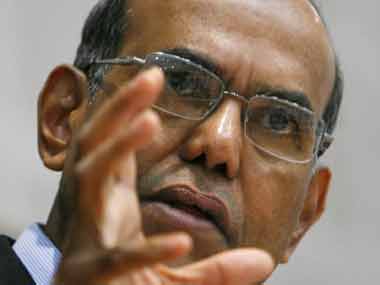It’s a deft stroke from Reserve Bank of India (RBI) Governor Duvvuri Subbarao. On Friday, he slashed the cash reserve ratio (CRR) - the proportion of deposits banks must keep with the central bank - by a hefty 75 basis points (0.75 percent), exactly a week ahead of the Union Budget, and six days before his next Monetary Policy review slated for 15 March.
In terms of timing, few can match this move. The RBI action will release as much as Rs 48,000 crore into a system struggling for liquidity and ease the concerns of banks and industry on the availability of cash in the system. It is also a strong enough signal that the RBI is using whatever tools are at its disposal to ensure that growth does not take a further beating because of a shortage of funds.
[caption id=“attachment_239570” align=“alignleft” width=“380” caption=“Reuters”]
 [/caption]
[/caption]
In January, the RBI had slashed CRR by 50 basis points in a clear signal that it is acutely aware of the stressed liquidity situation and was addressing the problem.
In addition, as RBI itself points out, it has also continued its open market operations (OMOs), injecting as much as Rs 1,24,500 crore into the system so far this fiscal.
But the problem was serious enough to warrant a big cut in CRR a week ahead of its policy review. Says the central bank: “Despite these measures, the liquidity deficit has remained large on account of both structural and frictional factors. This was reflected in the net average borrowing under the Reserve Bank’s liquidity adjustment facility (LAF) rising from an average ofRs 1,29,200 crore in January 2012 toRs 1,40,500 crore in February.”
Besides, the advance tax outflows due in the second week of March would have further squeezed liquidity out of the system, which is why RBI had to inject permanent liquidity by way of a CRR cut. The central bank makes it clear that despite its earlier moves, the liquidity deficit was still above its own comfort level, and hence the latest move.
But the bigger question for industry is, does this latest RBI move mean an interest rate cut is round the corner?
The answer is still not clear. In fact, many experts still believe that this CRR cut was once again more of a liquidity addressing move rather than one which is an immediate precursor to a cut in the repo rate, the rate at which banks borrow from the RBI. That would depend on broader structural factors, and RBI’s own view of inflation expectations.
So far, in the immediate context, there’s little to suggest that a rate cut will come about on 15 March, a day before Finance Minister Pranab Mukherjee presents his Budget. Subbarao and Mukherjee did have a discussion a few days ago, and the CRR cut follows that. Is there more to come? No one’s willing to stick his neck out just yet, not after Subbarao’s last policy announcement.
Consider two important aspects of Subbarao’s January policy review statement.
•RBI says “there is a large element of suppressed inflation as domestic prices of some administered products do not reflect the underlying market conditions. Revision in domestic administered prices will add to inflationary pressures, although I should note that such revisions are necessary to maintain the balance between supply and demand.”
•Second, the governor made it clear that the fiscal deficit of the government could potentially crowd out credit to the private sector. “Moreover, slippage in the fiscal deficit has been adding to inflationary pressures and it continues to be a risk for inflation,” says the Governor.
The second point, more than anything, will be the relevant one to watch now that there’s just a week to go before the Budget. Chances are, having cut CRR just now and set the stage for Mukherjee to act, the governor may well wait a while and watch what the Budget holds before making a decisive move on interest rates.
Inflation, after all, still remains the RBI’s biggest enemy, and he has attempted to oil the slowing growth engine a bit by infusing fresh liquidity (the CRR cut is effective 10 March). Some, however, are betting on a 25 basis points cut in the repo rate soon.
This is a bold RBI governor. And he has the ability to surprise either way. And as of now, he holds all the aces.
Sourav Majumdar has been a financial journalist for over 18 years. He has worked with leading business newspapers and covered the corporate sector and financial markets. He is based in Mumbai.
)